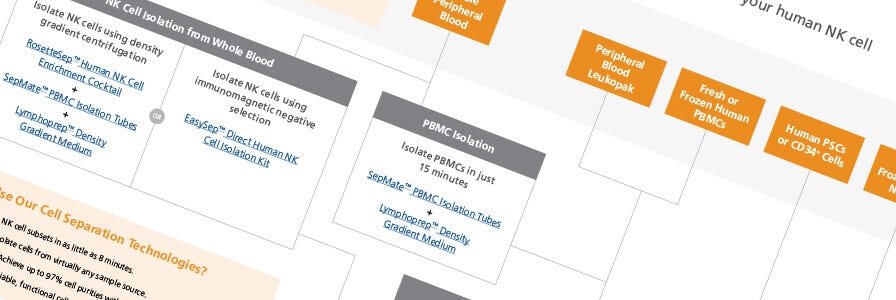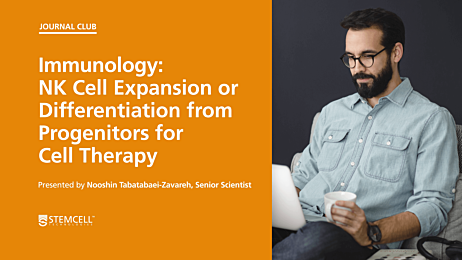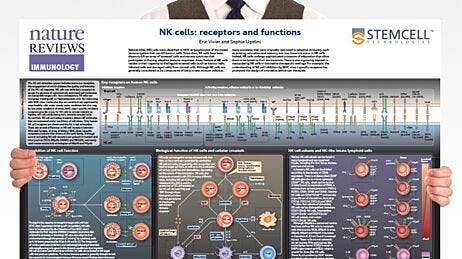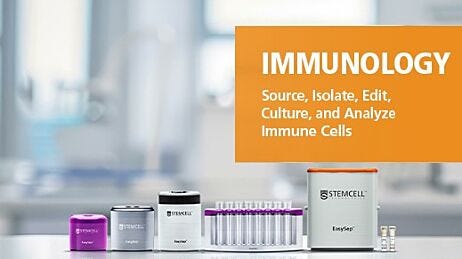Human NK Cell Isolation, Expansion, and Analysis
Natural killer (NK) cells are lymphocytes that provide defense against pathogens and tumors. Due to their secretion of pro-inflammatory cytokines and their ability to kill cancerous or virus-infected cells, NK cells play a critical role in innate immunity. The in vitro culture and expansion of these cells are useful tools for studying human immunity, NK cell biology, and their potential use in the development of immunotherapies.
To help you move your research forward, STEMCELL Technologies has developed products that support the complete NK cell workflow—from cell sourcing and isolation to gene editing, expansion, and analysis (Figure 1). Explore below for tips and tricks on how best to obtain high yields of functional NK cells for your research.

Figure 1. Integrated Workflow for Obtaining and Culturing Human NK Cells
(A) Isolate NK cells from fresh human whole blood or leukopaks using EasySep™ cell separation kits or RosetteSep™ enrichment cocktails. Fresh or frozen human primary NK cells can also be sourced directly from STEMCELL and immediately cultured in ImmunoCult™. (B) Gene edit isolated NK cells with ArciTect™ CRISPR-Cas9 system. (C) Expand and harvest NK cells by culturing the isolated NK cells with ImmunoCult™ Human NK Cell Expansion Kit for 14 days. Passage cells every 3 - 4 days and harvest NK cells for use in downstream applications. (D) Analyze NK cells using STEMCELL’s antibodies, ELISA kits, and cell dyes.
*Certain products are only available in select territories.
Source and Isolate NK Cells
Human NK cells can either be purchased directly or isolated from sources such as whole blood, leukopaks, peripheral blood mononuclear cells (PBMCs), and spleen using EasySep™ cell separation kits or RosetteSep™ enrichment cocktails. These isolation methods result in highly pure NK cells that are immediately ready for expansion, analysis, or use in other downstream applications.
Source Primary Human NK Cells
Streamline your assays with ready-to-use human NK cells isolated by positive or negative immunomagnetic selection from either peripheral blood or cord blood. With personalized service, custom products, flexible delivery times, and the option to reserve entire lots to prescreen cells for your applications, we help you get the cells you need*.
For more information about our primary cell products, please see our answers to frequently asked questions.
See all human primary cell products >
*Certain products are only available in select territories.
Start Your Workflow by Isolating NK Cells Using EasySep™
For experiments that require highly pure NK cells, it is necessary to enrich the samples prior to cell culture or expansion. EasySep™ is a fast, easy, and column-free immunomagnetic cell separation system for isolating highly purified NK cells. Figure 2 is a representative flow cytometry plot showing the high purity of NK cells in a sample cultured using ImmunoCult™ NK Cell Expansion Kit after enrichment with EasySep™.

Figure 2. EasySep™ Human NK Cell Isolation Kit Isolates NK Cells with High Purity
CD56+ NK cells freshly isolated from human PBMCs using EasySep™ Human NK Cell Isolation Kit were cultured with the ImmunoCult™ NK Cell Expansion Kit for 14 days. Cells were harvested and analyzed for expression of CD56 and CD3 by flow cytometry. (A) Representative flow cytometry plot. (B) The average frequency of viable CD56+CD3- NK cells on day 14 was 87% ±1%. The average fold expansion of CD56+CD3- cells was 88 ± 17. Results shown represent mean ± SEM (n = 34).
Depending on your starting sample, choose from the several different NK cell isolation kits available:
- EasySep™ Direct Human NK Cell Isolation Kit – Isolate NK cells from human whole blood by immunomagnetic negative selection
- EasySep™ Human NK Cell Isolation Kit and EasySep™ Human NK Cell Enrichment Kit – Isolate NK cells from fresh or previously frozen PBMCs
- EasySep™ Human CD56 Positive Selection Kit II – Isolate CD56+ NK cells from fresh or previously frozen PBMCs and human skeletal muscle cultures by positive selection
You can also perform immunodensity cell separation of NK cells by using RosetteSep™ and SepMate™ without any specialized equipment beyond a centrifuge; this method can be easily incorporated into established density gradient centrifugation protocols.
How to Isolate Human NK Cells
Learn how to isolate high yields of NK cells with the EasySep™ Human NK Cell Isolation Kit.
Watch Now >Isolate Cells from Large-Volume Samples with Easy 250 EasySep™ Magnet
Working with large-volume samples? Avoid splitting your cell suspension and performing multiple rounds of isolations by using the Easy 250 EasySep™ Magnet to process up to 225 mL and 11.25 x 109 cells in as little as 20 minutes with a single isolation. Use Easy 250 with EasySep™ reagents and a standard T-75 cm² cell culture flask to speed up your cell isolations from large-volume samples such as full-size leukopaks and whole blood. The isolated cells are immediately ready for downstream applications.
See how the Easy 250 EasySep™ Magnet performs in your lab by requesting a demo.
Explore more resources on cell separation technology:
- Resource Scale Up Your Cell Isolations
- E-Book Cell Separation Techniques–Everything You Need to Know
- Video How EasySep™ Magnetic Cell Separation Technology Works: Fast and Easy Cell Isolation
- Video How to Speed up Your PBMC Isolations with SepMate™
- How-To Video How to Isolate Untouched Human NK Cells
- Video Automate NK Cell Isolation with the RoboSep™-S Cell Separation Instrument
Can't Find the Cell Isolation Kit You Need?
If you're working with unique or rare immune cell subsets in your research but can't find a readily available cell separation kit, we can create custom cell separation products tailored to your specific research needs. Contact Product & Scientific Support at techsupport@stemcell.com to discuss your specific cell separation needs or connect with us on Live Chat.
Perform Gene Editing of NK Cells
Modify NK Cells with ArciTect™
In recent years, CRISPR-Cas9 technology has made genetically manipulating NK cells easier and more efficient. Beyond genetic manipulation for research purposes, CRISPR-Cas9 genome editing holds great potential for therapeutic applications, including immunotherapy and regenerative medicine. Genome editing of purified NK cells cultured for 3 - 4 days with ImmunoCult™ NK Cell Expansion Kit can be achieved by using ArciTect™ CRISPR-Cas9 ribonucleoprotein (RNP)-based system and STEMCELL’s Guide RNA Design Tool.

Figure 3. Experimental Workflow for Human NK Cell Genome Editing
Once a target locus for editing is identified, the ArciTect™ sgRNA (single guide RNA) or ArciTect™ crRNA (CRISPR RNA) sequences can be designed using the Single Guide RNA Design Tool or the CRISPR RNA Design Tool, respectively. NK cells can be purchased or isolated using column-free cell separation technology (e.g. EasySep™) from a number of sources, such as cord blood, bone marrow, or mobilized peripheral blood. Next, NK cells are cultured for 3 - 4 days in complete ImmunoCult™ NK Cell Expansion Medium on a plate pre-coated with ImmunoCult™ NK Cell Expansion Coating Material (1X). The ArciTect™ CRISPR-Cas9 ribonucleoprotein (RNP) is then prepared and delivered into NK cells using electroporation, and cells are plated in complete ImmunoCult™ NK Cell Expansion Medium post-electroporation. Editing efficiency can be analyzed using flow cytometry.
For detailed instructions on the isolation and activation of primary human NK cells, preparation of a CRISPR-Cas9 RNP complex, and delivery of an RNP complex into cells, see our full, step-by-step protocol.
We have found it is ideal for NK cells to be expanding prior to delivery of the ribonucleoprotein by electroporation. Immediately prior to RNP delivery, we mix the guide RNA and Cas9 enzyme, and then deliver it into the cells via electroporation.
Pro Tip from Our Scientist: Danielle Nguyen Truong, Scientist, STEMCELL Technologies
Culture NK Cells
14-Day Protocol for Feeder-Free and Serum-Free Expansion of Human NK Cells with ImmunoCult™
NK cells sourced from STEMCELL or isolated with EasySep™ are highly purified and immediately ready to be cultured and expanded. Achieving robust expansion of NK cells in culture historically required the addition of serum or feeder cells. Although the serum can improve performance, this is at the cost of high lot-to-lot variability in the composition of the serum and the risk of contamination by adventitious agents. Minimize this variability and risk by using serum-free medium and supplements, such as ImmunoCult™ NK Cell Base Medium and ImmunoCult™ Human NK Cell Expansion Supplement. To achieve the most optimal expansion, use the complete ImmunoCult™ Human NK Cell Expansion Kit, which is designed to give high cell yield and frequency without the use of serum, specialized cultureware, or feeder cells. View the protocol overview below.

Figure 4. ImmunoCult™ NK Cell Expansion Protocol
NK cells sourced from STEMCELL or isolated with EasySep™ were cultured in ImmunoCult™ NK Cell Expansion Medium, on plates coated with ImmunoCult™ NK Cell Expansion Coating Material. After 3 days, fresh medium was added to the culture. On day 7, and again on day 10 or 11, expanding NK cells were harvested and replated on freshly coated plates. Expanded NK cells were harvested on day 14 for use in downstream assays.
Find the Right NK Cell Isolation and Culture Product
Unsure which human NK cell isolation method and cell culture product are right for your research? Explore this chart to find the product best suited to your starting sample.
Download Now >Analyze and Characterize NK Cells
Expanded NK cells can be used in downstream applications and may be characterized using techniques such as flow cytometry, ELISA, microscopy, or assessed in functional assays. A killing assay (Figure 5) can measure the cells’ cytotoxicity directly, while a cytokine production assay (Figure 6) measures NK cell degranulation and their ability to produce cytokines. Degranulating cells are identifiable by surface expression of CD107a, a lysosomal associated membrane protein, and cytokine production can be detected in stimulated cells via intracellular staining.
The figures below show how NK cells cultured and expanded with the ImmunoCult™ NK Cell Expansion Kit are able to kill K562 cells in co-culture (Figure 5) and, furthermore, are able to degranulate and produce cytokines after stimulation (Figure 6).

Figure 5. Expanded NK Cells Are Functional, Killing K562 Cells in Co-Culture
Isolated CD56+CD3− NK cells were expanded and then co-cultured with Incucyte® Cytolight Rapid Dye-labeled K562 cells at 1:1 ratio of NK:K562 cells at 37°C for 4 hours. Incucyte® Caspase-3/7 Dye, a caspase-inducible dye, was added to the co-culture to detect caspase-induced apoptosis of the K562 cells. Images were obtained every hour using the Incucyte® imaging system and then analyzed to determine % killing (# apoptotic K562 cells ÷ # total labeled K562 cells). After 4 hours, an average of 48 ± 2.4% K562 cells were killed (n = 9). Data represent mean ± SEM.

Figure 6. Expanded NK Cells Degranulate and Produce Cytokines After Stimulation
Isolated CD56+CD3− NK cells were expanded for 14 days, as described in Figure 4. Expanded NK cells were left unstimulated (control) or were stimulated with either phorbol 12-myristate 13-acetate (PMA) and ionomycin or K562 cells at a ratio of 1:1 effector:target cells. CD107a antibody was added, and cultures were incubated at 37°C for 4 hours. After the first hour, Monensin and Brefeldin A were added. Cells were assessed for surface CD56, CD107a, and intracellular IFN-γ and TNF-α expression by flow cytometry. (A-C) Representative histograms of CD107a, IFN-γ, and TNF-α expression of unstimulated (grey filled), PMA and ionomycin-stimulated (orange), and K562-stimulated (purple) NK cell samples. (D) The average frequency of NK cells expressing surface CD107a, a marker of degranulation, was 23 ± 5% for the unstimulated control, 88 ± 5% after stimulation with PMA and ionomycin, and 74 ± 6% after stimulation with K562 cells. (E) The average frequency of NK cells expressing intracellular IFN-γ was 10 ± 2% for the unstimulated control, 75 ± 4% for cells stimulated with PMA and ionomycin, and 48 ± 4% for cells co-cultured with K562 cells. (F) The average frequency of NK cells expressing intracellular TNF-α was 6 ± 4% for the unstimulated control, 85 ± 1% cells stimulated with PMA and ionomycin, and 45 ± 4% for cells co-cultured with K562 cells. Data represent mean ± SEM (n = 6 - 13).
Targeting NK Cells for Use in Immunotherapies?
Are you looking to use STEMCELL products as ancillary materials (AMs) or raw materials in the manufacture of cellular therapies? STEMCELL’s Services for Cell Therapy Program can support the qualification of our products as ancillary/raw materials by providing extended quality documentation and customized solutions to meet your specific clinical needs. To learn more about how we can support your preclinical and clinical research needs, visit www.stemcell.com/sct or speak with your STEMCELL sales representative.
Need help with setting up your experiments or want to chat with one of our experts? Get in contact with us via LiveChat or send us an email at techsupport@stemcell.com.







